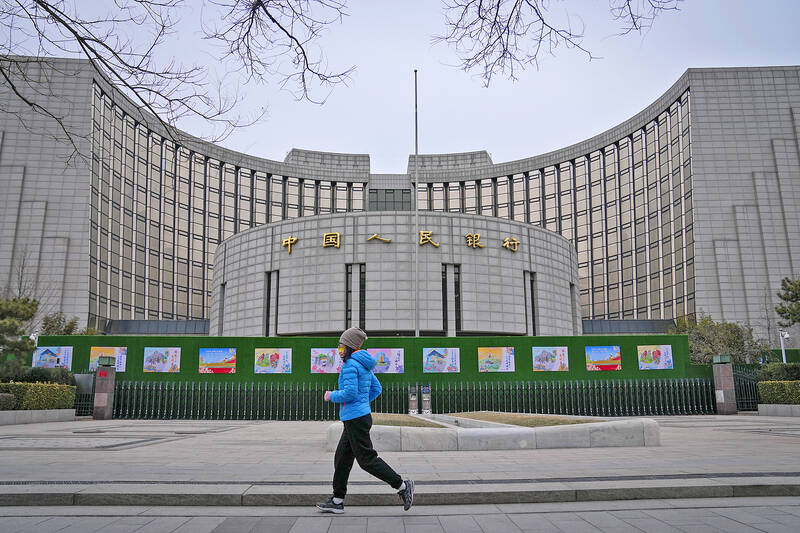China yesterday ramped up support for its property sector with its biggest-ever cut to a key mortgage reference rate, raising expectations for more aggressive measures to support the economy in the months to come.
Chinese lenders slashed their five-year loan prime rate (LPR) by 25 basis points to 3.95 percent, the People’s Bank of China said.
It was the first cut since June last year and the largest reduction since a revamp of the rate was rolled out in 2019.

Photo: AP
Lowering that rate will allow more cities in China to reduce minimum mortgage rates for homebuyers, which might stimulate sluggish demand for apartments as prices fall. The move shows an intensifying focus on measures to combat the property crisis, which has been a major drag on the world’s second-largest economy.
“It is delivering stronger dose of easing to the economy,” said Michelle Lam (林雪潔), an economist at Societe Generale SA.
The cut might reflect more support for mortgage demand and long-term corporate loans “while reducing risks of idle use of funds,” Lam said.
Banks also maintained their one-year LPR — the de facto benchmark lending rate — at 3.45 percent.
While expectations for a smaller reduction in the five-year LPR were fairly widespread, economists were split on a one-year LPR cut.
The move failed to impress investors.
China’s benchmark CSI 300 Index was down about 0.3 percent in morning trade. The offshore yuan gained 0.1 percent as the central bank set a strong daily reference rate, while the currency traded onshore was unchanged. Yields on China’s government bonds — which have been falling on greater bets for easing — slipped 1 basis point to 2.43 percent.
“A bigger cut may boost housing sentiment in the near-term, though this unlikely marks a turnaround in the property sector,” said Alex Loo, a macro strategist at TD Securities in Singapore.
Loo cited the China’s “urgency” to entice more homebuyers as property sales in key cities slumped during the week-long Lunar New Year holiday.
Next month is traditionally a peak season for home sales, making any efforts to spur more purchases all the more timely.
Even so, it was not clear whether the five-year LPR cut would offer much of a boost. The average rate of new mortgages granted in December last year had already fallen to a record low of 3.97 percent, while mega-cities such as Beijing, Shanghai and Guangzhou have been relaxing curbs on home purchases for months.
The cut will probably provide the most benefit for new homebuyers right now, as many existing mortgages — which were worth 38 trillion yuan (US$5.28 trillion) at the end of last year — are only repriced at the beginning of the year.
Several economists pointed to the need for additional easing this year — including through cuts to the central banks one-year policy loan rate, or the medium-term lending facility rate.
The People’s Bank of China refrained from lowering that rate on Sunday, making yesterday’s action the first time since May 2022 that the five-year LPR rate was cut following a hold on the medium-term lending facility rate.
The LPRs are based on the interest rates that 20 banks offer their best customers and are quoted as a spread over the central bank’s medium-term lending facility rate.
The central bank, which publishes the LPRs monthly, is seen as having significant sway over them.

CHIP RACE: Three years of overbroad export controls drove foreign competitors to pursue their own AI chips, and ‘cost US taxpayers billions of dollars,’ Nvidia said China has figured out the US strategy for allowing it to buy Nvidia Corp’s H200s and is rejecting the artificial intelligence (AI) chip in favor of domestically developed semiconductors, White House AI adviser David Sacks said, citing news reports. US President Donald Trump on Monday said that he would allow shipments of Nvidia’s H200 chips to China, part of an administration effort backed by Sacks to challenge Chinese tech champions such as Huawei Technologies Co (華為) by bringing US competition to their home market. On Friday, Sacks signaled that he was uncertain about whether that approach would work. “They’re rejecting our chips,” Sacks

NATIONAL SECURITY: Intel’s testing of ACM tools despite US government control ‘highlights egregious gaps in US technology protection policies,’ a former official said Chipmaker Intel Corp has tested chipmaking tools this year from a toolmaker with deep roots in China and two overseas units that were targeted by US sanctions, according to two sources with direct knowledge of the matter. Intel, which fended off calls for its CEO’s resignation from US President Donald Trump in August over his alleged ties to China, got the tools from ACM Research Inc, a Fremont, California-based producer of chipmaking equipment. Two of ACM’s units, based in Shanghai and South Korea, were among a number of firms barred last year from receiving US technology over claims they have

It is challenging to build infrastructure in much of Europe. Constrained budgets and polarized politics tend to undermine long-term projects, forcing officials to react to emergencies rather than plan for the future. Not in Austria. Today, the country is to officially open its Koralmbahn tunnel, the 5.9 billion euro (US$6.9 billion) centerpiece of a groundbreaking new railway that will eventually run from Poland’s Baltic coast to the Adriatic Sea, transforming travel within Austria and positioning the Alpine nation at the forefront of logistics in Europe. “It is Austria’s biggest socio-economic experiment in over a century,” said Eric Kirschner, an economist at Graz-based Joanneum

OPTION: Uber said it could provide higher pay for batch trips, if incentives for batching is not removed entirely, as the latter would force it to pass on the costs to consumers Uber Technologies Inc yesterday warned that proposed restrictions on batching orders and minimum wages could prompt a NT$20 delivery fee increase in Taiwan, as lower efficiency would drive up costs. Uber CEO Dara Khosrowshahi made the remarks yesterday during his visit to Taiwan. He is on a multileg trip to the region, which includes stops in South Korea and Japan. His visit coincided the release last month of the Ministry of Labor’s draft bill on the delivery sector, which aims to safeguard delivery workers’ rights and improve their welfare. The ministry set the minimum pay for local food delivery drivers at